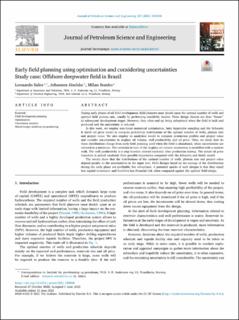| dc.contributor.author | Sales, Leonardo de Pádua Agripa | |
| dc.contributor.author | Jäschke, Johannes | |
| dc.contributor.author | Stanko, Milan | |
| dc.date.accessioned | 2021-10-15T10:17:07Z | |
| dc.date.available | 2021-10-15T10:17:07Z | |
| dc.date.created | 2021-06-18T08:20:10Z | |
| dc.date.issued | 2021 | |
| dc.identifier.issn | 0920-4105 | |
| dc.identifier.uri | https://hdl.handle.net/11250/2823277 | |
| dc.description.abstract | During early phases of oil field development, field planners must decide upon the optimal number of wells and optimal field plateau rate, usually by performing sensitivity studies. These design choices are then “frozen” in subsequent development stages. However, they often end up being suboptimal when the field is built and produced and the uncertainty is reduced.
In this work, we employ non-linear numerical optimisation, latin hypercube sampling and the Schwartz & Smith oil price model to compute probability distributions of the optimal number of wells, plateau rate and project value. We also employ an analytical model to compute production profiles and project value and consider uncertainties in in-place oil volume, well productivity and oil price. Then, we study how do these distributions change from early field planning until when the field is abandoned, when uncertainties are reduced to a minimum. The variation in time of the in-place oil volume uncertainty is modelled with a random walk. The well productivity is a step function altered randomly after production startup. The actual oil price trajectory is picked randomly from possible trajectories computed with the Schwartz and Smith model.
The results show that the distributions of the optimal number of wells, plateau rate and project value depend greatly on the uncertainties in the input data. Field designs based on the average of the distributions during the early phase are profitable, but suboptimal. A potential upside of such designs is that they entail less capital investment and therefore less financial risk when compared against the optimal field design. | en_US |
| dc.language.iso | eng | en_US |
| dc.publisher | Elsevier | en_US |
| dc.rights | Navngivelse 4.0 Internasjonal | * |
| dc.rights.uri | http://creativecommons.org/licenses/by/4.0/deed.no | * |
| dc.title | Early field planning using optimisation and considering uncertainties - Study case: Offshore deepwater field in Brazil | en_US |
| dc.type | Peer reviewed | en_US |
| dc.type | Journal article | en_US |
| dc.description.version | publishedVersion | en_US |
| dc.source.journal | Journal of Petroleum Science and Engineering | en_US |
| dc.identifier.doi | https://doi.org/10.1016/j.petrol.2021.109058 | |
| dc.identifier.cristin | 1916629 | |
| dc.relation.project | Norges forskningsråd: 237893 | en_US |
| cristin.ispublished | true | |
| cristin.fulltext | preprint | |
| cristin.qualitycode | 2 | |

